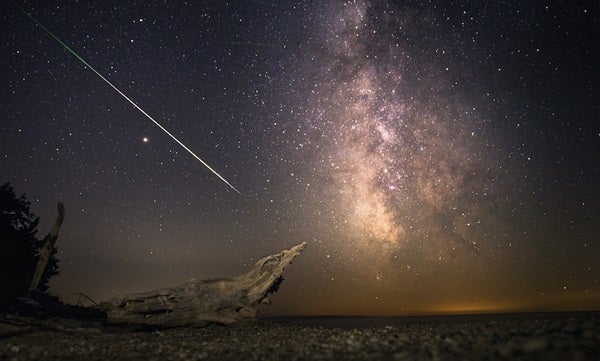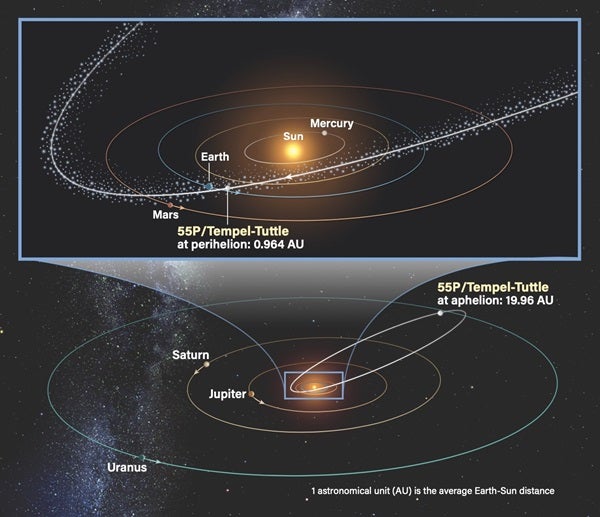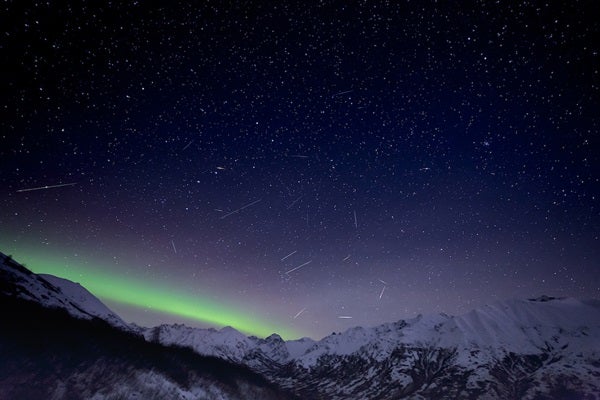The Leonids, arguably history’s most important annual meteor shower, may have a treat in store for us this November. Classically, the shower peaks each year in mid-November. But the 2022 show may captivate those at key locations across the globe with multiple encore performances, one of which could be a dazzler. What’s more, with a waning Moon setting before the best viewing opportunities begin, this year offers observers great opportunities to capture the most of any activity.
Meteor showers are curious phenomena. While astronomers are becoming ever more precise in their predictions of when maximum shower activity will occur, the number of meteors one will see with the unaided eyes at any given location is less certain. Researchers are also exploring ways to determine the brightness of expected meteors, but surprises are always a possibility.
The Leonid meteor shower occurs when Earth sails through a trail of particles released from the periodic comet 55P/Tempel-Tuttle. This comet orbits the Sun once every 33 years and crosses Earth’s orbit along the way. Typically, Leonid activity starts around Nov. 14, peaks around Nov. 17, and ends around Nov. 21.
The nucleus of 55P/Tempel-Tuttle is relatively small, measuring just over 2.2 miles (3.6 kilometers) across. The dusty fragments it leaves behind in its orbit, which create the Leonid meteors, are minute in comparison — most have sizes similar to granules of instant coffee. But when these fragments collide with our atmosphere, friction heats the air around the moving particles, causing them to glow. The result: fiery streaks in the sky, popularly known as shooting or falling stars.
Among the swiftest meteors, the Leonids pack a punch. Fragments penetrate Earth’s atmosphere at 44 miles per second (71 km/s). The smallest particles create swift, needlelike streaks. Larger fragments (those the size of a pea or slightly bigger) can create fireballs as magnificent as Venus or brighter. When seen from rural locations, these fireballs sometimes brighten the landscape enough to cast shadows. If you’re extremely fortunate, a Leonid fragment the size of your fist can create a spectacle as bright as the Full Moon.
Normally, Leonid peak rates can be as low as one meteor every six minutes (even under perfect conditions), but more outstanding displays occur once every 33 years or so — sometimes reaching storm level, with at least 1,000 meteors per hour, or what I call super-storm levels of 100,000 meteors or more per hour, when the heavens appear to weep.
Leonids to dazzle in 2022?
While the 2022 Leonid shower is not expected to storm, it may dazzle — but not on the night of its traditional peak, at least according to some meteor scientists.
The International Meteor Organization lists this year’s classical maximum at 11 P.M. UT on Nov. 17, with a zenithal hourly rate (ZHR) of 10 to 15 meteors per hour. The ZHR is the calculated maximum number of meteors a skilled observer would expect to see in one hour under a perfectly dark and clear sky with the shower radiant overhead. Most observers usually see only a fraction of the ZHR value.
Occasionally, the brightest meteors can leave persistent glowing trains — a cylindrical trail of ionized atoms that remains in the meteor’s wake. So, given that the Leonid meteors are not only bright but also swift and colorful, just spotting a few Leonids can make a night’s observing memorable. And if Russian meteor scientist Mikhail Maslov and Nippon Meteor Society member Mikiya Sato are correct, we may be in for a surprise following the Leonids’ traditional peak.
Each time 55P/Tempel-Tuttle rounds the Sun, it sheds debris, which solar wind and gravitational interactions can mold into dense streams of material. These streams, spaced out along the comet’s orbit at specific locations, orbit the Sun either ahead of or behind the comet. As Earth crosses 55P/Tempel-Tuttle’s orbit, it will encounter whatever streams of dust happen to be present at that time.
This year, a strong outburst of Leonid meteors is possible on Nov. 19 from a debris stream shed by the comet in 1733. Maslov predicts the event at 6 A.M. UT, while Sato predicts it a little later, between 6:20 A.M. and 6:27 A.M. UT. Sato predicts a ZHR of 50 or more meteors per hour. Maslow goes even further: Despite uncertainties, he says it’s possible the outburst will produce a ZHR of 250 or more meteors — many of which will be much brighter than average. Either option offers exciting possibilities. If the outburst occurs, it will favor observers in western Europe, Africa, and the East Coast of North America.
The activity period could be brief. But if it lasts longer, observers farther west may get lucky as well. Viewers along the East Coast of North America and perhaps those in the Central time zone may benefit from some exceptional sights, especially from meteors that strike Earth’s atmosphere tangentially while the radiant is just on the rise. Such meteors can have long durations, upping the “wow” factor.
A weaker supernumerary peak may also occur Nov. 18 at 7 A.M. UT, as Earth encounters a debris trail left by a passage around the year 1600, and a possible spike in activity could happen Nov. 21 at 3 P.M. UT, as Earth encounters an 1800 debris stream.
How best to observe
The shower’s radiant (for the star chart, see Sky This Month on page 29) does not rise until local midnight and will be highest from your location only before dawn. And luckily, pre-dawn viewing times are the best for meteor observing because that’s when your observing site begins to swing headlong into the debris stream. So the best way to approach this year’s Leonid shower is to prepare for a five-day, early-morning vigil Nov. 16–21.
Imagine Earth as a car speeding down the highway. Just as bugs more frequently splatter onto the front windshield than the rear windshield, so too will Leonid meteors appear to smash more frequently into Earth’s atmosphere as our planet races forward into the comet’s debris stream.
Where should you look? While the paths of shower meteors can be traced back to a point in the Sickle of Leo, most appear as streaks of light some distance away from that radiant. Shower meteors near or at the radiant may appear as a short, swift flash or a point source that swells. Meteors farther from the radiant will take the form of longer streaks of light. Both are remarkable, so split your time between looking at the radiant and slightly away.
In the latter case, it’s best to focus your attention on an area some 20° to 40° (two to four fist-widths) away from the radiant and about halfway up the sky, as you will cover more area. The same advice generally applies for those wanting to image the event.
As a general rule, the farther a meteor is from the radiant, the longer its path. It’s important to know where the shower radiant lies, however, as you will need to trace the meteor’s path back to make sure any meteor you see is not sporadic — a rogue meteor whose path cannot be traced back to a specific source.
A nighttime treat
I can’t expound enough on why these displays are worth your while. If Nov. 19 produces anything at all like the display I saw on the morning of Nov. 16, 1999, it should not be missed.
On that morning, observers at some lucky locations across the globe saw a splendid shower of about 250 fireballs per hour fall from the heavens. And while this was not a storm, the grandeur and magnitude of the meteors will be forever etched on my mind — especially considering that a weird flashing through my bedroom window woke me up that night. Once outside, I saw 30 dazzling fireballs and four other meteors fall from the Sickle of Leo over 45 minutes.
Even if numbers like that don’t materialize this year, given that the Leonids are already noted for their brilliance, any increase in brightness or number will be a welcome sight come Nov. 19.
Ultimately, although we don’t know if any of the 2022 Leonid events will visually shock and awe, it’s best to be prepared for whatever the shower tosses our way. As always, with meteor observing, expect the unexpected!












